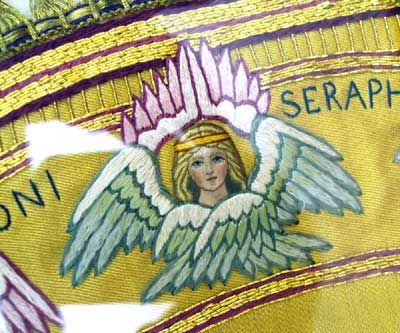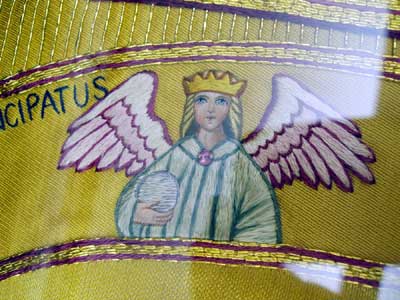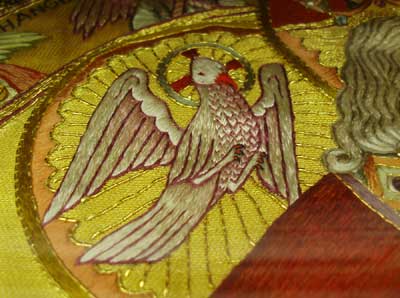Continuing through my collection of liturgical and church-related embroidery photos, here’s a glorious embroidered piece – the hood of a cope, with figure embroidery. Like the Last Supper chasuble I posted yesterday and the Crucifixion chasuble I posted photos of last year, this is relatively “modern” work – first half of the 1900’s sometime.
The embroidered image on the cope hood is God the Father, holding Christ in His arms, with the Holy Ghost over the right shoulder. Around the figures are the choirs of angels. The cope hood would be approximately two feet long, and a little less wide.

The majority of the work is done in long and short stitch or split stitch shading techniques.

The individual angels representing the choirs of angels are probably about 3 or 4 inches high. I regret that I didn’t take accurate measurements when I photographed these! The detail and the color are quite nice.

There are nine choirs of angels depicted, each one represented by the wings or by what is held in their hands. I don’t know the precise symbolism.

The dove that represents the Holy Ghost caught my eye on this piece, as the outlines are embroidered in red, rather than the typical black or dark grey.

Because the piece was in a glass-covered drawer, I couldn’t get a direct shot of the crown or face details here. You can see gemstones (probably glass) and pearls worked on the crown.

The shading on the face of Christ is really very nicely done. It looks better from far away than it does close up, in my opinion (as does the whole piece). This is often the case in ecclesiastical work – the pieces are embroidered and shaded according to how they will look from a distance, since one of the reasons they are made is for the edification of the faithful, who would be viewing them from the distance in the congregation, rather than close up in the sanctuary of a larger church.
The clasp on the cloak of God the Father is set with gemstones and pearls as well. You can see drill marks in the glass stones when the image is enlarged.

The goldwork on the embroidered part is done in imitation Japanese gold. You can see the wide wraps around the core thread. The gold on the fringe, though, is undoubtedly real gold which has tarnished over the years. The fringe was more than likely purchased complete rather than prepared by those who worked the embroidery.
Again, another quick meditation on the type of work that must have gone into such pieces! Ecclesiastical embroidery for vestments was usually done either by convents with many hands involved in the embroidery, or by guilds, who also had several ladies who would take part in creating a piece. A work like this would be a major long-term project for one individual!







It rather looks like the shading is created more by padding than by colored thread. The stitcher had to sculpt the face and hair locks with pad stitches. I think it is less thread painting than pad sculpting. What’s your opinion?
Oh this cope, I think it’s long and short stitch… I can post a close-up of one of the faces or the cloak so you can see it better. One of the problems is the angle. I think I took a couple more horizontal shots, because I was rather amazed how 2-dimensional the piece is. It’s flat, with no hills or valleys. There are some spots – like on the forehead – that look as if they are padded then stitched over, but there really isn’t any physical depth to the darker areas.
The whole piece was stitched first on linen then appliqued, so you can see a little bit of depth where the figures meet the ground fabric.
On the chasuble I posted yesterday, I’m really not entirely sure what’s stitched under the evenly spaced split stitch lines that cover the faces and hair and that give it shading. But it’s flat, too.
On the pelican I will post later today, it’s definitely padded and stitched over, then stitched over again with long lines of split stitch. I have no idea how the padding’s done, but I would LOVE to know. Do you know of a source, Laura??
Thanks!!!